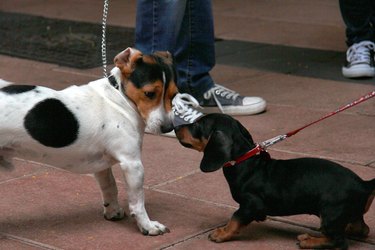
A dog who lunges, barks and snaps at another canine can suck the joy from walks or owning multiple dogs. You may assume that your dog is just naturally aggressive, but his bad behavior is just a signal that something is missing in his life. You can stop his aggressive behavior by making sure he is fulfilled and providing him with calm, capable leadership.
Aggression in the Home
Video of the Day
Dominant Aggression
Lack of calm, decisive leadership by his human leaves a dog trying to assume the pack leader role himself. In homes where there is more than one dog, this can lead to fighting for the role. Being a decisive leader doesn't mean being harsh or demanding. The pack leader concerns himself with the welfare of the pack, not just his own needs.
Video of the Day
Solution: Establish rules in your dog's life and enforce them consistently to help him relinquish his need for dominance. Rules include making him perform a task such as sitting or lying down before giving him his toys or food, walking behind you and learning basic obedience commands. Dogs cease fighting each other for control of the pack when they see you as a calm pack leader.
Fighting Over Resources
Whether it's food, toys or your attention, a dog may show aggression toward another dog when he feels he needs to guard his resources. The behavior starts when the dog lowers his head, stiffens and raises his hackles. He may hover protectively over a toy or food bowl, and he may sit on your feet or lap to claim you as his. Without intervention, the aggressive behavior may escalate to growling, snapping or a full-blown fight.
*Solution: *Feed your dogs in separate rooms or crates so they don't feel a need to protect their food. Exercise your dogs at least 30 minutes before meal time to release frustration or anxiety. You can counter-condition your dog's protectiveness by teaching him the "drop it" command and rewarding him with a treat of higher value when he does as you ask. If it's you he's guarding, teach the "go" command and send him away whenever he positions himself protectively in front of you.
The Aggressive Couch Potato
Dogs who stay home all day may handle their frustration and lack of entertainment with over-excitement once they get to venture out into the world. Overexcited energy can cause them to lunge and bark when they see another dog. An overly excited dog may seem not to hear or notice when you attempt to calmly correct his behavior.
Solution: Dog behaviorist Cesar Millan recommends taking a dog for a walk every four hours during the day. When this isn't practical, he recommends walking your pet for 35 minutes to an hour twice daily. Provide your dog with mental stimulation, such as chews and treat-dispensing puzzle toys, during the hours he must be at home.
Aggression on the Walk
It's easy to become apprehensive when another dog approaches, and a dog will pick up on that fearful energy. He senses the other dog as a threat and moves into a position to defend his fearful pack mate. The dog typically moves out in front of his owner towards the oncoming dog, lunging and snarling to ward off the intruder. The other dog may interpret his protective body language as aggression and a fight might ensue. Picking up a small dog each time another dog approaches further reinforces the aggressive behavior by communicating that going ballistic will get rewarded with affection.
Solution: Have your dog walk at your side and slightly behind you to assert your position as pack leader. Should he lunge toward another dog, keep yourself from yelling or hauling back on the leash. Instead, give a tug to the side as you correct him. Don't allow your dog to continue barking and lunging, but have your dog follow as you continue your walk as planned.
If you're joining a friend's dog on a walk, resist letting the dogs meet head on. Take time to properly introduce your dog to another dog he'll be spending time with. Introduce the dogs by walking them in the same direction with one ahead of the other. Let them take turns sniffing the other's bottom as you move along. In about 30 minutes, the dogs will feel relaxed in one another's presence.
Tip
A professional dog behaviorist or trainer can help you see and correct things you may be doing to perpetuate aggressive behavior.